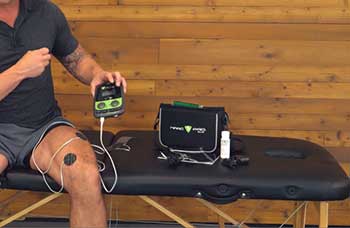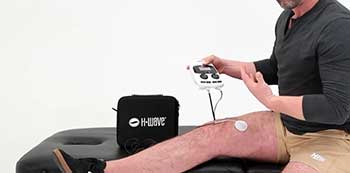Muscle stimulators are becoming an increasingly popular way to treat muscle pain and injuries. Two of the most well-known brands on the market are Marc Pro and H-Wave.
But what exactly do these devices do and how do they compare? Let’s take a detailed look at the pros and cons of Marc Pro and H-Wave to help you decide which is best for your needs.
A Brief Comparison Table
| Feature | Marc Pro | H-Wave |
| Cost | Around $649 | Over $4,295 |
| Waveform Technology | Nonlinear proprietary waveforms | Proprietary H-Wave waveforms |
| Mechanism of Action | Alternating fast/slow pulses to fatigue muscle | Mimics body’s natural nerve impulses |
| Treatment Sessions | 30-60 mins | Up to 10 hours per day |
| FDA Clearance | Muscle spasms, pain relief, range of motion | Post-surgical pain, chronic pain |
| Portability | Compact, easy to use device | Small controller with sticky pads |
| Evidence | Some studies support effects | Limited clinical data |
Overview Of Marc Pro And H-Wave
The Marc Pro and H-Wave are both neuromuscular electrical stimulators. This means they send electrical impulses to your muscles to make them contract and relax.
The main goals of these devices are to:
- Relieve muscle pain and spasms
- Improve range of motion
- Accelerate injury recovery
Both devices are portable and easy to self-administer at home. Treatment sessions typically last 30-60 minutes. Most people use them 1-2 times per day.
Now let’s dive into how these two stimulators compare.
Marc Pro Overview

The Marc Pro is a patented electrical muscle stimulator created by a company called Marc Pro. It was initially designed to help prevent muscle atrophy in astronauts during space travel.
The Marc Pro uses proprietary waveforms that alternate between fast and slow pulses. This dual-pulse system aims to fatigue the muscles and achieve a deep contraction.
Some key features and benefits of the Marc Pro include:
- Patented stimulation waveforms – The Marc Pro uses unique stimulation patterns that differ from traditional stim devices. This aims to improve treatment effects.
- Deep muscle contraction – The dual pulses allow for a deeper and more forceful contraction than basic stim units. This helps “re-educate” the muscles.
- Portable and easy to use – The Marc Pro has a sleek, compact design. The intensity levels are adjustable to customize the experience.
- May shorten recovery – Studies show the Marc Pro may accelerate recovery from injuries/surgeries involving muscles, tendons or nerves.
- FDA cleared – The Marc Pro is cleared by the FDA for treating muscle spasms, range of motion, and pain relief.
H-Wave Overview
H-Wave is another form of neuromuscular electrical stimulation. It was developed by Electronic Waveform Lab Inc. in the 1990s.
The H-Wave device emits proprietary H-Wave waveform signals. The stimulation patterns differ from traditional interferential and TENS devices.
Here are some of the key features and purported benefits:

- Unique stimulation waveforms – The H-Wave waveforms are meant to better mimic the body’s natural nerve impulses.
- Improves range of motion – Many users report improved flexibility and mobility in the treated areas.
- Reduces muscle spasms – The H-Wave may help relieve cramping and involuntary muscle contractions.
- Portable device – The H-Wave has a small controller that’s easy to use at home or work. The pads stick directly on the skin.
- Drug-free pain relief – The H-Wave aims to reduce pain and inflammation without medications.
- FDA cleared – H-Wave has FDA clearance to treat post-surgical and chronic pain.
Now let’s directly compare the pros and cons of these two stim devices.
Marc Pro Vs. H-Wave: Key Differences
While the Marc Pro and H-Wave have some similarities, they have some important differences:
Stimulation Types
- Marc Pro: Uses proprietary nonlinear waveforms and dual pulses
- H-Wave: Emits patented H-Wave stimulation signals
Mechanism of Action
- Marc Pro: Alternates fast/slow pulses to deeply fatigue the muscle
- H-Wave: Mimics the body’s natural nerve impulses
Intended Uses
- Marc Pro: Cleared by FDA for pain relief, spasm reduction, and increasing range of motion
- H-Wave: Cleared by FDA for pain management, muscle re-education, and hypertonic muscle relaxation
Cost
- Marc Pro: Around $649 for device and gel kit
- H-Wave: Roughly $4,295 for stim device, accessories, supplies
Evidence
- Marc Pro: Some clinical studies support its use
- H-Wave: Limited clinical data available
As you can see, there are some key differences in how these two stim devices work, their regulatory clearances, the cost, and the level of evidence supporting each.
Below we’ll explore the pros and cons of each device in more detail.
Also Read: Choose Among Compex, Powerdot And Marc Pro.
Marc Pro Pros And Cons
Marc Pro Pros
- Unique waveforms may offer advantages over traditional stim
- Compact, easy-to-use device
- May shorten recovery from muscle injuries
- Requires shorter treatment sessions than H-Wave
- More affordable price point
Marc Pro Cons
- Lacks long-term studies on effectiveness and safety
- “Deep pulsing” sensation may be uncomfortable for some
- Not always covered by insurance
H-Wave Pros And Cons
H-Wave Pros
- Proprietary waveforms may enhance effects
- May improve range of motion better than basic TENS
- Gets FDA clearance for pain relief
- Can be used with complementary therapies
H-Wave Cons
- Very expensive (thousands of dollars)
- Uses sticky pads that must be replaced
- Mixed clinical evidence on benefits
- Long treatment sessions required (up to 10 hours/day)
- Not broadly covered by insurance
As you can see, both the Marc Pro and H-Wave have their own sets of advantages and disadvantages. The Marc Pro is more affordable and convenient, while the H-Wave may offer advanced waveform technology.
Also watch the video of Marc Pro!
Frequently Asked Questions (FAQ)
The Marc Pro uses patented nonlinear waveforms and dual-pulse stimulation that aim to provide deeper muscle fatigue and re-education. This differs from traditional TENS and interferential devices.
The Marc Pro costs around $649. While not cheap, this is far less than the $4,295+ price tag of the H-Wave. The higher cost of the Marc Pro device may come from the advanced technology and waveforms used.
For those seeking an easy-to-use and effective muscle stim device, the Marc Pro is likely worth the price. The unique stimulation patterns may offer advantages over basic TENS units. However, there is limited clinical data on the Marc Pro’s effects long-term.
The Marc Pro differs from a traditional TENS unit in a few key ways:
Uses patented nonlinear waveforms
Alternates fast and slow pulses
Aims to deeply fatigue muscle
Gets FDA clearance for muscle contraction
Costs considerably more than most basic TENS units
So in summary, the Marc Pro goes beyond a TENS unit to provide a different stimulation pattern and experience.
Final Thoughts
In the battle of Marc Pro versus H-Wave, there’s no universally “best” option. The Marc Pro offers a convenient and relatively affordable middle ground between basic TENS and the advanced H-Wave technology. It aims to provide a novel stimulation pattern for short, deep muscle contractions.
The H-Wave uses proprietary signals that may mimic the body’s natural impulses. But it comes at a steep price and requires longer, more frequent treatment sessions.
At the end of the day, consult your healthcare provider to decide if one of these neuromuscular stim devices could benefit your muscle pain and mobility issues. While evidence is still limited, both the Marc Pro and H-Wave may provide an advantage over traditional stim units for some individuals.
